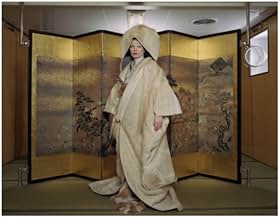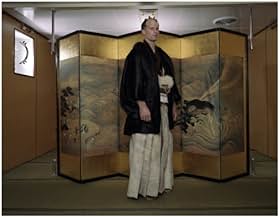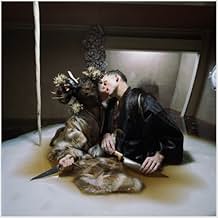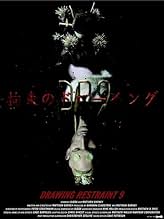NOTE IMDb
6,5/10
1,6 k
MA NOTE
Ajouter une intrigue dans votre langueThe film concerns the theme of self-imposed limitation and continues Matthew Barney's interest in religious rite, this time focusing on Shinto.The film concerns the theme of self-imposed limitation and continues Matthew Barney's interest in religious rite, this time focusing on Shinto.The film concerns the theme of self-imposed limitation and continues Matthew Barney's interest in religious rite, this time focusing on Shinto.
- Récompenses
- 1 nomination au total
Avis à la une
I just saw this the other day. I Was in the second row of the cinema so close to all these weird happenings. I knew that it would be slow and hardly without a story. With that in mind I really liked the slow moving pictures, the building of the big Vaseline-sculpture, and the meeting between Björk and Barney(it takes a long time before they actually meet on screen)
I see why some people would find it annoying, but to me it had some stunning visuals and the music was really good.
Just sit back and relax and don't expect much more than two hours of slow moving and weird stuff.
I see why some people would find it annoying, but to me it had some stunning visuals and the music was really good.
Just sit back and relax and don't expect much more than two hours of slow moving and weird stuff.
As with reading all comments, you will find it useful to know where the writer is placed. I have watched the first "Cremaster" and Barney's entry in the "Destricted" compilation. That latter piece was a failure in my mind. There's not much overlap between the sculptural and the cinematic anyway. One is more on the noun side, the other on the verb side: contextual, environmental. I admire that he tried to find that commonality in the erotic, but the result is rather sophomoric in all but the initial choices.
This isn't wonderful either. I hold hope for the later "Cremaster" experiences, that there will be some valuable conversation between us. This is a wholly different thing altogether. This man has found his love, and has created a valentine. Its a conversation, an intercourse between the two of them. The value we are expected to get is in witnessing rather than participating.
The forms he has chosen are all Japanese because they have developed an observational distance with the ordinary things of their life we do not have.
The basic urge here is the melding of the two lives: Bjarney, but with careful, artificial constraints. We have the merging of the tea ceremony with the whaling ritual; the reversal of rendering blubber to whaleoil to the coagulation of pseudoblubber from pseudowhaleoil.
We have the melding of humans with whales, ambergris with pearls, constructing whale icons with consumption...
And of course the conflating of Barney's sculptural objects with Japanese ritualistic ones. I am not well enough versed in details of Japanese esoterica to know where one starts and the other stops, but I suppose in his view it is perfectly balanced, one "restraining" the other; one "drawing" the other, each drawing restraints on another level: tea to whale and so on.
The most engaging sequence is at the beginning: three phenomenal episodes: one the wrapping of two packages, bodies; a second the procession of the whale oil returned and ritual construction thereupon; and finally a dive into the water seeking marine truth, revealing a hot blade (seen later as the humans transform into whales).
Its not for us, they made this. Its a conversation of love and commitment between the two. We've only crew members.
Ted's Evaluation -- 3 of 3: Worth watching.
This isn't wonderful either. I hold hope for the later "Cremaster" experiences, that there will be some valuable conversation between us. This is a wholly different thing altogether. This man has found his love, and has created a valentine. Its a conversation, an intercourse between the two of them. The value we are expected to get is in witnessing rather than participating.
The forms he has chosen are all Japanese because they have developed an observational distance with the ordinary things of their life we do not have.
The basic urge here is the melding of the two lives: Bjarney, but with careful, artificial constraints. We have the merging of the tea ceremony with the whaling ritual; the reversal of rendering blubber to whaleoil to the coagulation of pseudoblubber from pseudowhaleoil.
We have the melding of humans with whales, ambergris with pearls, constructing whale icons with consumption...
And of course the conflating of Barney's sculptural objects with Japanese ritualistic ones. I am not well enough versed in details of Japanese esoterica to know where one starts and the other stops, but I suppose in his view it is perfectly balanced, one "restraining" the other; one "drawing" the other, each drawing restraints on another level: tea to whale and so on.
The most engaging sequence is at the beginning: three phenomenal episodes: one the wrapping of two packages, bodies; a second the procession of the whale oil returned and ritual construction thereupon; and finally a dive into the water seeking marine truth, revealing a hot blade (seen later as the humans transform into whales).
Its not for us, they made this. Its a conversation of love and commitment between the two. We've only crew members.
Ted's Evaluation -- 3 of 3: Worth watching.
There's no dialogue for a while, and then there's some Japanese dialogue, and all the while, I didn't really know what was going on. I was lost at pretty much all times, but that was to be expected. This had "avant-garde" written all over it, and for being an art piece, I guess it's sporadically interesting. It probably achieves what it sets out to do, but whatever that is feels unclear to me. If you want to dive in, there's probably a lot to chew on, but as to whether it would taste any good, who knows. Probably not. But it's challenging. That's more of an observation rather than something that makes it bad or good. And there's some music here composed by Bjork, though she didn't do all the music it seems. I don't know.
That's my take away. I don't know.
That's my take away. I don't know.
DR9 shouldn't really be thought of as a film in the traditional sense of the word, nor should it sit alone, its part of a greater work of art, the clue is in the title! To really appreciate the film it helps to see it in relation to sculpture and the way objects interact within a chosen space. also the resonance of ritual and especially Japanese shinto can bring a certain amount of meaning and clarity to some of the more obscure sequences in the film. even though it seems very 'serious and arty' on the surface ,there is humour and romance and the film! try not to see it as a finite static thing, but something that can change according to the multiple layers you allow yourself to perceive it on.
It you are Japanese or know something about Japanese mythology and/or whaling culture in japan, then this movie will mean a lot more to you than others.
I know most people who watch this movie will come out of the theater ferociously hating Matthew Barney and be turned off of modern art, but for me, this movie was grounded in ancient Japanese traditions. And to have witnessed it, even if it is bastardized from it's Japanese roots, is a fortunate event.
I'll attempt to write the plot as I saw it.
Barney and Bjork were invited onto the whaling vessel as guests. They begin their journey by transforming into sea spirits through several elaborate and beautiful (however long and confusing) ceremonies and rites of passages . This all happens while the whaling crew perform their duties on the symbolic whale. In the end the journey takes a gruesome turn and the transformation is complete.
This is by no means an easy movie to sit through, be forewarned. However, I believe the value is in your furthered exploration into the subject of Japanese culture, ritual and mythology.
Be sure to check out the exhibit at your local museum if it comes to your town. It is absolutely amazing to see.
I know most people who watch this movie will come out of the theater ferociously hating Matthew Barney and be turned off of modern art, but for me, this movie was grounded in ancient Japanese traditions. And to have witnessed it, even if it is bastardized from it's Japanese roots, is a fortunate event.
I'll attempt to write the plot as I saw it.
Barney and Bjork were invited onto the whaling vessel as guests. They begin their journey by transforming into sea spirits through several elaborate and beautiful (however long and confusing) ceremonies and rites of passages . This all happens while the whaling crew perform their duties on the symbolic whale. In the end the journey takes a gruesome turn and the transformation is complete.
This is by no means an easy movie to sit through, be forewarned. However, I believe the value is in your furthered exploration into the subject of Japanese culture, ritual and mythology.
Be sure to check out the exhibit at your local museum if it comes to your town. It is absolutely amazing to see.
Le saviez-vous
- Bandes originalesGratitude
Written by Björk and Matthew Barney
Vocal by Will Oldham
Harp played by Zeena Parkins
Celeste played by Jónas Sen
Keyboard played by Nico Muhly
Arranging & editing by Björk
Programming by Björk and Valgeir Sigurðsson
Produced by Björk
Meilleurs choix
Connectez-vous pour évaluer et suivre la liste de favoris afin de recevoir des recommandations personnalisées
- How long is Drawing Restraint 9?Alimenté par Alexa
Détails
Box-office
- Montant brut aux États-Unis et au Canada
- 234 743 $US
- Week-end de sortie aux États-Unis et au Canada
- 18 011 $US
- 2 avr. 2006
- Montant brut mondial
- 267 275 $US
- Durée2 heures 15 minutes
- Couleur
- Mixage
- Rapport de forme
- 1.85 : 1
Contribuer à cette page
Suggérer une modification ou ajouter du contenu manquant

Lacune principale
By what name was Drawing Restraint 9 (2005) officially released in Canada in English?
Répondre






















